filter
Filter disturbances using univariate ARIMA or ARIMAX model
Description
Y = filter(Mdl,Z)Y resulting
from filtering the numeric array of one or more underlying disturbance series
Z through the fully specified, univariate ARIMA model
Mdl. Z is associated with the model innovations
process that drives the specified ARIMA model.
Tbl2 = filter(Mdl,Tbl1)Tbl2 containing the results from
filtering the paths of disturbances in the input table or timetable
Tbl1 through Mdl. The disturbance variable in
Tbl1 is associated with the model innovations process through
Mdl. (since R2023b)
filter selects the variable
Mdl.SeriesName, or the sole variable in Tbl1, as
the disturbance variable to filter through the model. To select a different variable in
Tbl1 to filter through the model, use the
DisturbanceVariable name-value argument.
[___] = filter(___,
specifies options using one or more name-value arguments in
addition to any of the input argument combinations in previous syntaxes.
Name,Value)filter returns the output argument combination for the
corresponding input arguments. For example, filter(Mdl,Z,Z0=PS,X=Pred) filters the
numeric vector of disturbances Z through the ARIMAX
Mdl, and specifies the numeric vector of presample disturbance data
PS to initialize the model and the exogenous predictor data
X for the regression component.
Examples
Compute the impulse response function (IRF) of an ARMA model by filtering a vector of zeros, representing disturbances, through the model.
Specify a mean zero ARMA(2,0,1) model.
Mdl = arima(Constant=0,AR={0.5 -0.8},MA=-0.5, ...
Variance=0.1);Simulate the first 20 responses of the IRF. Generate a disturbance series with a one-time, unit impulse, and then filter it.
z = [1; zeros(19,1)]; y = filter(Mdl,z);
y is a 20-by-1 response path resulting from filtering the disturbance path z through the model. y represents the IRF. The filter function requires one presample observation to initialize the model. By default, filter uses the unconditional mean of the process, which is 0.
y = y/y(1);
Normalize the IRF such that the first element is 1.
Plot the impulse response function.
figure stem((0:numel(y)-1)',y,"filled"); title("Impulse Response")
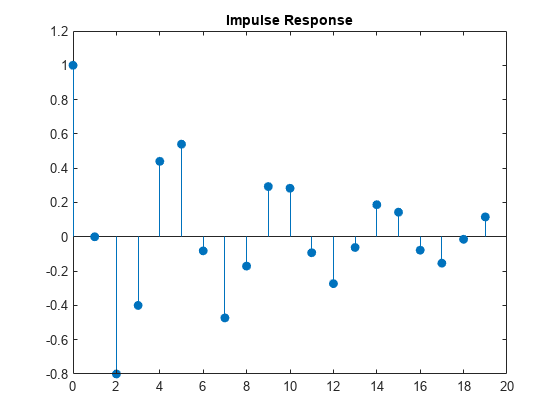
The impulse response assesses the dynamic behavior of a system to a one-time, unit impulse.
Alternatively, you can use the impulse function to plot the IRF for an ARIMA process.
Filter a matrix of disturbance paths. Return the paths of responses and innovations, which drive the data-generating processes.
Create a mean zero ARIMA(2,0,1) model.
Mdl = arima(Constant=0,AR={0.5,-0.8},MA=-0.5, ...
Variance=0.1);Generate 20 random, length 100 paths from the model.
rng(1,"twister"); % For reproducibility [ySim,eSim,vSim] = simulate(Mdl,100,NumPaths=20);
ySim, eSim, and vSim are 100-by-20 matrices of 20 simulated response, innovation, and conditional variance paths of length 100, respectively. Because Mdl does not have a conditional variance model, vSim is a matrix completely composed of the value of Mdl.Variance.
Obtain disturbance paths by standardizing the simulated innovations.
zSim = eSim./sqrt(vSim);
Filter the disturbance paths through the model.
[yFil,eFil] = filter(Mdl,zSim);
yFil and eFil are 100-by-20 matrices. The columns are independent paths generated from filtering corresponding disturbance paths in zSim through the model Mdl.
Confirm that the outputs of simulate and filter are identical.
sameE = norm(eSim - eFil) < eps
sameE = logical
1
sameY = norm(ySim - yFil) < eps
sameY = logical
1
The logical values 1 confirm the outputs are effectively identical.
Since R2023b
Fit an ARIMA(1,1,1) model to the weekly average NYSE closing prices. Supply a timetable of data and specify the series for the fit. Then, filter randomly generated Gaussian noise paths through the estimated model to simulate responses and innovations.
Load Data
Load the US equity index data set Data_EquityIdx.
load Data_EquityIdx
T = height(DataTimeTable)T = 3028
The timetable DataTimeTable includes the time series variable NYSE, which contains daily NYSE composite closing prices from January 1990 through December 2001.
Plot the daily NYSE price series.
figure
plot(DataTimeTable.Time,DataTimeTable.NYSE)
title("NYSE Daily Closing Prices: 1990 - 2001")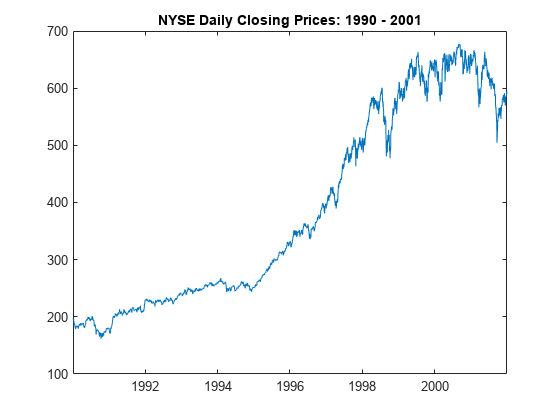
Prepare Timetable for Estimation
When you plan to supply a timetable, you must ensure it has all the following characteristics:
The selected response variable is numeric and does not contain any missing values.
The timestamps in the
Timevariable are regular, and they are ascending or descending.
Remove all missing values from the timetable, relative to the NYSE price series.
DTT = rmmissing(DataTimeTable,DataVariables="NYSE");
T_DTT = height(DTT)T_DTT = 3028
Because all sample times have observed NYSE prices, rmmissing does not remove any observations.
Determine whether the sampling timestamps have a regular frequency and are sorted.
areTimestampsRegular = isregular(DTT,"days")areTimestampsRegular = logical
0
areTimestampsSorted = issorted(DTT.Time)
areTimestampsSorted = logical
1
areTimestampsRegular = 0 indicates that the timestamps of DTT are irregular. areTimestampsSorted = 1 indicates that the timestamps are sorted. Business day rules make daily macroeconomic measurements irregular.
Remedy the time irregularity by computing the weekly average closing price series of all timetable variables.
DTTW = convert2weekly(DTT,Aggregation="mean"); areTimestampsRegular = isregular(DTTW,"weeks")
areTimestampsRegular = logical
1
T_DTTW = height(DTTW)
T_DTTW = 627
DTTW is regular.
figure
plot(DTTW.Time,DTTW.NYSE)
title("NYSE Daily Closing Prices: 1990 - 2001")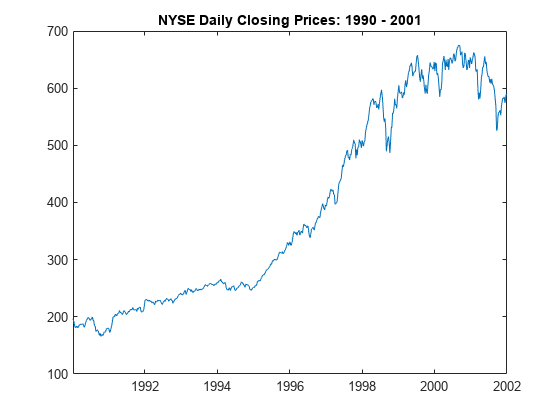
Create Model Template for Estimation
Suppose that an ARIMA(1,1,1) model is appropriate to model NYSE composite series during the sample period.
Create an ARIMA(1,1,1) model template for estimation. Set the response series name to NYSE.
Mdl = arima(1,1,1);
Mdl.SeriesName = "NYSE";Mdl is a partially specified arima model object.
Fit Model to Data
Fit an ARIMA(1,1,1) model to weekly average NYSE closing prices. Specify the entire series.
EstMdl = estimate(Mdl,DTTW);
ARIMA(1,1,1) Model (Gaussian Distribution):
Value StandardError TStatistic PValue
________ _____________ __________ ___________
Constant 0.86385 0.46496 1.8579 0.06318
AR{1} -0.37582 0.22719 -1.6542 0.098093
MA{1} 0.47221 0.21741 2.1719 0.02986
Variance 55.89 1.832 30.507 2.1204e-204
EstMdl is a fully specified, estimated arima model object. By default, estimate backcasts for the required Mdl.P = 2 presample responses.
Filter Random Gaussian Disturbance Paths
Generate 2 random, independent series of length T_DTTW from the standard Gaussian distribution. Store the matrix of series as one variable in DTTW.
rng(1,"twister") % For reproducibility DTTW.Z = randn(T_DTTW,2);
DTTW contains a new variable called Z containing a T_DTTW-by-2 matrix of two disturbance paths.
Filter the paths of disturbances through the estimated ARIMA model. Specify the table variable name containing the disturbance paths.
Tbl2 = filter(EstMdl,DTTW,DisturbanceVariable="Z");
tail(Tbl2) Time NYSE NASDAQ Z NYSE_Response NYSE_Innovation NYSE_Variance
___________ ______ ______ _____________________ ________________ ___________________ ______________
16-Nov-2001 577.11 1886.9 -1.8948 0.41292 358.78 433.57 -14.166 3.087 55.89 55.89
23-Nov-2001 583 1898.3 1.3583 0.27051 367.95 436.63 10.155 2.0223 55.89 55.89
30-Nov-2001 581.41 1925.8 -0.9118 1.1119 363.35 445.61 -6.8165 8.3125 55.89 55.89
07-Dec-2001 584.96 1998.1 -0.14964 -2.418 361.61 428.95 -1.1187 -18.077 55.89 55.89
14-Dec-2001 574.03 1981 -0.40114 0.98498 359.6 434.9 -2.9989 7.3636 55.89 55.89
21-Dec-2001 582.1 1967.9 -0.57758 0.0039243 355.48 437.04 -4.318 0.029338 55.89 55.89
28-Dec-2001 590.28 1967.2 2.0039 -0.92415 370.84 430.2 14.981 -6.9089 55.89 55.89
04-Jan-2002 589.8 1950.4 -0.50964 -0.43856 369.19 427.09 -3.8101 -3.2787 55.89 55.89
size(Tbl2)
ans = 1×2
627 6
Tbl2 is a 627-by-6 timetable containing all variables in DTTW, and the two filtered response paths NYSE_Response, innovation paths NYSE_Innovation, and constant variance paths NYSE_Variance (Mdl.Variance = 55.89).
Assess the dynamic behavior of a system to a persistent change in a variable by plotting a step response. Supply presample responses to initialize the model.
Specify a mean zero ARIMA(2,0,1) process.
Mdl = arima(Constant=0,AR={0.5 -0.8},MA=-0.5, ...
Variance=0.1);Simulate the first 20 responses to a sequence of unit disturbances. Generate a disturbance series of ones, and then filter it. Set all presample observations equal to zero.
Z = ones(20,1); Y = filter(Mdl,Z,Y0=zeros(Mdl.P,1)); Y = Y/Y(1);
The last step normalizes the step response function to ensure that the first element is 1.
Plot the step response function.
figure stem((0:numel(Y)-1)',Y,"filled"); title("Step Response")
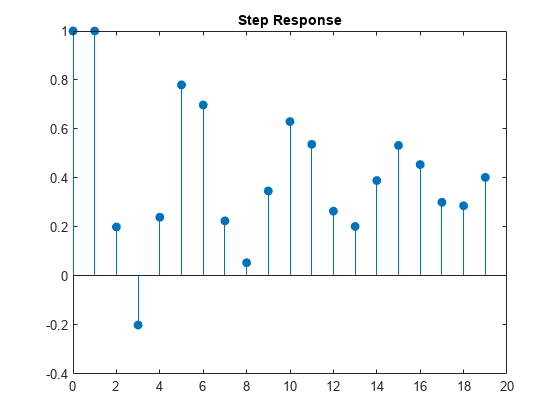
Create models for the response and predictor series. Set an ARIMAX(2,1,3) model to the response MdlY, and an AR(1) model to the MdlX.
MdlY = arima(AR={0.1 0.2},D=1,MA={-0.1 0.1 0.05}, ...
Constant=1,Variance=0.5,Beta=2);
MdlX = arima(AR=0.5,Constant=0,Variance=0.1);Simulate a length 100 predictor series x and a series of iid normal disturbances z having mean zero and variance 1.
rng(1,"twister")
z = randn(100,1);
x = simulate(MdlX,100);Filter the disturbances z using MdlY to produce the response series y. Plot y.
y = filter(MdlY,z,X=x); figure plot(y); xlabel("Time") ylabel("Response")
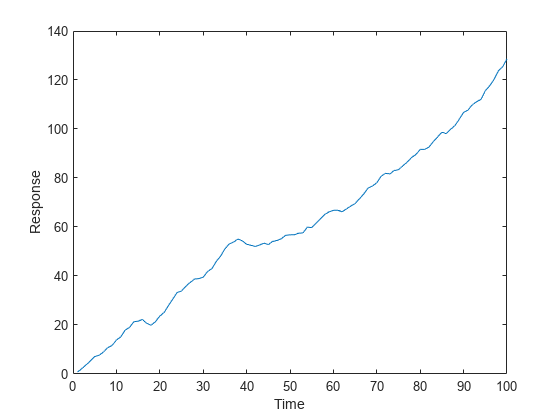
Create the composite AR(1)/GARCH(1,1) model
Create the composite model.
CVMdl = garch(Constant=0.2,GARCH=0.1,ARCH=0.05); Mdl = arima(Constant=1,AR=0.5,Variance=CVMdl)
Mdl =
arima with properties:
Description: "ARIMA(1,0,0) Model (Gaussian Distribution)"
SeriesName: "Y"
Distribution: Name = "Gaussian"
P: 1
D: 0
Q: 0
Constant: 1
AR: {0.5} at lag [1]
SAR: {}
MA: {}
SMA: {}
Seasonality: 0
Beta: [1×0]
Variance: [GARCH(1,1) Model]
Mdl is an arima object. The property Mdl.Variance contains a garch object that represents the conditional variance model.
Generate a random series of 100 standard Gaussian of disturbances.
rng(1,"twister") % For reproducibility z = randn(100,1);
Filter the disturbances through the model. Return and plot the simulated conditional variances.
[y,e,v] = filter(Mdl,z); plot(z)
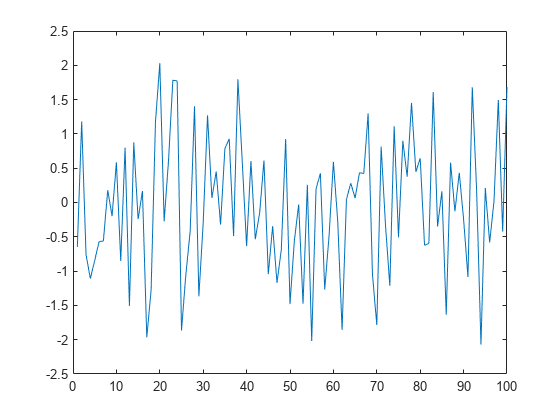
Input Arguments
Underlying disturbance paths zt, specified
as a numobs-by-1 numeric column vector or
numobs-by-numpaths numeric matrix.
numObs is the length of the time series (sample size).
numpaths is the number of separate, independent disturbance
paths.
zt drives the innovation process εt. For a variance process σt2, the innovation process is
Each row corresponds to a sampling time. The last row contains the latest set of disturbances.
Each column corresponds to a separate, independent path of disturbances.
filter assumes that disturbances across any row occur
simultaneously.
Z is the continuation of the presample disturbances
Z0.
Data Types: double
Since R2023b
Time series data containing the observed disturbance variable
zt, associated with the model innovations
process εt, and, optionally, predictor
variables xt, specified as a table or
timetable with numvars variables and numobs rows.
You can optionally select the disturbance variable or numpreds
predictor variables by using the DisturbanceVariable or
PredictorVariables name-value arguments, respectively.
For a variance process σt2, the innovation process is
Each row is an observation, and measurements in each row occur simultaneously. The
selected disturbance variable is a single path (numobs-by-1 vector)
or multiple paths (numobs-by-numpaths matrix) of
numobs observations of disturbance data.
Each path (column) of the selected disturbance variable is independent of the other
paths, but path jjnumpaths. Each selected predictor variable is a
numobs-by-1 numeric vector representing one path. The
filter function includes all predictor variables in the
model when it filters each disturbance path. Variables in Tbl1
represent the continuation of corresponding variables in
Presample.
If Tbl1 is a timetable, it must represent a sample with a
regular datetime time step (see isregular), and the datetime vector Tbl1.Time must be
strictly ascending or descending.
If Tbl1 is a table, the last row contains the latest
observation.
Name-Value Arguments
Specify optional pairs of arguments as
Name1=Value1,...,NameN=ValueN, where Name is
the argument name and Value is the corresponding value.
Name-value arguments must appear after other arguments, but the order of the
pairs does not matter.
Before R2021a, use commas to separate each name and value, and enclose
Name in quotes.
Example: filter(Mdl,Z,Z0=PS,X=Pred) specifies the numeric vector of
presample disturbance data PS to initialize the model and the exogenous
predictor data X for the regression component.
Since R2023b
Disturbance variable zt to select from
Tbl1 containing the disturbance data to filter through
Mdl, specified as one of the following data types:
String scalar or character vector containing a variable name in
Tbl1.Properties.VariableNamesVariable index (positive integer) to select from
Tbl1.Properties.VariableNamesA logical vector, where
DisturbanceVariable(selects variablej) = truejTbl1.Properties.VariableNames
The selected variable must be a numeric vector and cannot contain missing values
(NaNs).
If Tbl1 has one variable, the default specifies that variable.
Otherwise, the default matches the variable to names in
Mdl.SeriesName.
Example: DisturbanceVariable="StockRateDist"
Example: DisturbanceVariable=[false false true false] or
DisturbanceVariable=3 selects the third table variable as the
disturbance variable.
Data Types: double | logical | char | cell | string
Presample response data yt to initialize
the model, specified as a numpreobs-by-1 numeric column vector or a
numpreobs-by-numprepaths numeric matrix. Use
Y0 only when you supply the numeric array of disturbance data
Z.
numpreobs is the number of presample observations.
numprepaths is the number of presample response paths.
Each row is a presample observation (sampling time), and measurements in each row
occur simultaneously. The last row contains the latest presample observation.
numpreobs must be at least Mdl.P to initialize
the AR model component. If numpreobs > Mdl.P,
filter uses the latest required observations only.
Columns of Y0 are separate, independent presample paths. The
following conditions apply:
If
Y0is a column vector, it represents a single response path.filterapplies it to each output path.If
Y0is a matrix, each column represents a presample response path.filterappliesY0(:,to initialize pathj)j.numprepathsmust be at leastnumpaths. Ifnumprepaths>numpaths,filteruses the firstsize(Z,2)columns only.
By default, filter sets any necessary presample
responses to one of the following values:
The unconditional mean of the model when
Mdlrepresents a stationary AR process without a regression componentZero when
Mdlrepresents a nonstationary process or when it contains a regression component
Data Types: double
Presample disturbance data zt providing
initial values for the input disturbance series Z, specified as a
numpreobs-by-1 numeric column vector or a
numpreobs-by-numprepaths numeric matrix. Use
Z0 only when you supply the numeric array of disturbance data
Z.
Each row is a presample observation (sampling time), and measurements in each row
occur simultaneously. The last row contains the latest presample observation.
numpreobs must be at least Mdl.Q to initialize
the MA model component. If Mdl.Variance is a conditional variance
model (for example, a garch model object),
filter can require more rows than
Mdl.Q. If numpreobs is larger than required,
filter uses the latest required observations only.
Columns of Z0 are separate, independent presample paths. The
following conditions apply:
If
Z0is a column vector, it represents a single disturbance path.filterapplies it to each output path.If
Z0is a matrix, each column represents a presample disturbance path.filterappliesZ0(:,to initialize pathj)j.numprepathsmust be at leastnumpaths. Ifnumprepaths>numpaths,filteruses the firstsize(Z,2)columns only.
By default, filter sets the necessary presample
disturbances to zero.
Data Types: double
Presample conditional variance data
σt2 used to
initialize the conditional variance model, specified as a
numpreobs-by-1 positive numeric column vector or a
numpreobs-by-numprepaths positive numeric
matrix. If the conditional variance Mdl.Variance is constant,
filter ignores V0. Use
V0 only when you supply the numeric array of disturbance data
Z.
Each row is a presample observation (sampling time), and measurements in each row
occur simultaneously. The last row contains the latest presample observation.
numpreobs must be at least Mdl.Q to initialize
the conditional variance model in Mdl.Variance. For details, see
the filter function of conditional variance
models. If numpreobs is larger than required,
filter uses the latest required observations only.
Columns of V0 are separate, independent presample paths. The
following conditions apply:
If
V0is a column vector, it represents a single path of conditional variances.filterapplies it to each output path.If
V0is a matrix, each column represents a presample path of conditional variances.filterappliesV0(:,to initialize pathj)j.numprepathsmust be at leastnumpaths. Ifnumprepaths>numpaths,filteruses the firstsize(Z,2)columns only.
By default, filter sets all necessary presample
conditional variances to the unconditional variance of the conditional variance
process.
Data Types: double
Since R2023b
Presample data containing paths of response
yt, disturbance
zt, or conditional variance
σt2 series to
initialize the model, specified as a table or timetable, the same type as
Tbl1, with numprevars variables and
numpreobs rows. Use Presample only when you
supply a table or timetable of data Tbl1.
Each selected variable is a single path (numpreobs-by-1 vector)
or multiple paths (numpreobs-by-numprepaths
matrix) of numpreobs observations representing the presample of the
response, disturbance, or conditional variance series for
DisturbanceVariable, the selected disturbance variable in
Tbl1.
Each row is a presample observation, and measurements in each row occur
simultaneously. numpreobs must be one of the following values:
At least
Mdl.PwhenPresampleprovides only presample responsesAt least
Mdl.QwhenPresampleprovides only presample disturbances or conditional variancesAt least
max([Mdl.P Mdl.Q])otherwise
When Mdl.Variance is a conditional variance model,
filter can require more than the minimum required number
of presample values.
If you supply more rows than necessary, filter uses the
latest required number of observations only.
If Presample is a timetable, all the following conditions
must be true:
Presamplemust represent a sample with a regular datetime time step (seeisregular).The inputs
Tbl1andPresamplemust be consistent in time such thatPresampleimmediately precedesTbl1with respect to the sampling frequency and order.The datetime vector of sample timestamps
Presample.Timemust be ascending or descending.
If Presample is a table, the last row contains the latest
presample observation.
By default, filter sets the following values:
For necessary presample responses:
The unconditional mean of the model when
Mdlrepresents a stationary AR process without a regression componentZero when
Mdlrepresents a nonstationary process or when it contains a regression component.
For necessary presample disturbances, zero.
For necessary presample conditional variances, the unconditional variance of the conditional variance model n
Mdl.Variance.
If you specify the Presample, you must specify the presample
response, disturbance, or conditional variance name by using the
PresampleResponseVariable,
PresampleDisturbanceVariable, or
PresampleVarianceVariable name-value argument.
Since R2023b
Response variable yt to select from
Presample containing presample response data, specified as one of
the following data types:
String scalar or character vector containing a variable name in
Presample.Properties.VariableNamesVariable index (positive integer) to select from
Presample.Properties.VariableNamesA logical vector, where
PresampleResponseVariable(selects variablej) = truejPresample.Properties.VariableNames
The selected variable must be a numeric matrix and cannot contain missing values
(NaNs).
If you specify presample response data by using the Presample
name-value argument, you must specify
PresampleResponseVariable.
Example: PresampleResponseVariable="Stock0"
Example: PresampleResponseVariable=[false false true false] or
PresampleResponseVariable=3 selects the third table variable as
the presample response variable.
Data Types: double | logical | char | cell | string
Since R2023b
Disturbance variable zt to select from
Presample containing presample disturbance data, specified as one
of the following data types:
String scalar or character vector containing a variable name in
Presample.Properties.VariableNamesVariable index (positive integer) to select from
Presample.Properties.VariableNamesA logical vector, where
PresampleDisturbanceVariable(selects variablej) = truejPresample.Properties.VariableNames
The selected variable must be a numeric matrix and cannot contain missing values
(NaNs).
If you specify presample disturbance data by using the
Presample name-value argument, you must specify
PresampleDisturbanceVariable.
Example: PresampleDisturbanceVariable="StockRateDist0"
Example: PresampleDisturbanceVariable=[false false true false]
or PresampleDisturbanceVariable=3 selects the third table variable
as the presample disturbance variable.
Data Types: double | logical | char | cell | string
Since R2023b
Conditional variance variable
σt2 to select
from Presample containing presample conditional variance data,
specified as one of the following data types:
String scalar or character vector containing a variable name in
Presample.Properties.VariableNamesVariable index (positive integer) to select from
Presample.Properties.VariableNamesA logical vector, where
PresampleVarianceVariable(selects variablej) = truejPresample.Properties.VariableNames
The selected variable must be a numeric vector and cannot contain missing values
(NaNs).
If you specify presample conditional variance data by using the
Presample name-value argument, you must specify
PresampleVarianceVariable.
Example: PresampleVarianceVariable="StockRateVar0"
Example: PresampleVarianceVariable=[false false true false] or
PresampleVarianceVariable=3 selects the third table variable as
the presample conditional variance variable.
Data Types: double | logical | char | cell | string
Exogenous predictor data for the regression component in the model, specified as a
numeric matrix with numpreds columns. numpreds
is the number of predictor variables (numel(Mdl.Beta)). Use
X only when you supply the numeric array of disturbance data
Z.
X must have at least numobs rows. The last
row contains the latest predictor data. If X has more than
numobs rows, filter uses only the
latest numobs rows. Each row of X corresponds to
each period in Z (period for which
filter filters errors; the period after the
presample).
filter does not use the regression component in the
presample period.
Columns of X are separate predictor variables.
filter applies X to each filtered
path; that is, X represents one path of observed predictors.
By default, filter excludes the regression component,
regardless of its presence in Mdl.
Data Types: double
Since R2023b
Exogenous predictor variables xt to select
from Tbl1 containing predictor data for the regression component,
specified as one of the following data types:
String vector or cell vector of character vectors containing
numpredsvariable names inTbl1.Properties.VariableNamesA vector of unique indices (positive integers) of variables to select from
Tbl1.Properties.VariableNamesA logical vector, where
PredictorVariables(selects variablej) = truejTbl1.Properties.VariableNames
The selected variables must be numeric vectors and cannot contain missing values
(NaNs).
By default, filter excludes the regression component,
regardless of its presence in Mdl.
Example: PredictorVariables=["M1SL" "TB3MS" "UNRATE"]
Example: PredictorVariables=[true false true false] or
PredictorVariable=[1 3] selects the first and third table
variables to supply the predictor data.
Data Types: double | logical | char | cell | string
Note
NaNvalues inZ,X,Y0,Z0, andV0indicate missing values.filterremoves missing values from specified data by list-wise deletion.For the presample,
filterhorizontally concatenates the possibly jagged arraysY0,Z0, andV0with respect to the last rows, and then it removes any row of the concatenated matrix containing at least oneNaN.For in-sample data,
filterhorizontally concatenates the possibly jagged arraysZandX, and then it removes any row of the concatenated matrix containing at least oneNaN.
This type of data reduction reduces the effective sample size and can create an irregular time series.
For numeric data inputs,
filterassumes that you synchronize the presample data such that the latest observations occur simultaneously.filterissues an error when any table or timetable input contains missing values.
Output Arguments
Simulated response paths yt, returned as a
length numobs column vector or a
numobs-by-numpaths numeric matrix.
filter returns Y only when you supply
the input Z.
For each tnumobs, the simulated response at time
tY( corresponds to the filtered
disturbance at time t,:)tZ( and response path
t,:)jY(:, corresponds to the filtered
disturbance path j)jZ(:,.j)
Y represents the continuation of the presample response paths
in Y0.
Conditional variance paths
σt2, returned as
a length numobs column vector or
numobs-by-numpaths numeric matrix.
filter returns V only when you supply
the input Z. The dimensions of Y and
V correspond.
If Z is a matrix, then the columns of V are
the filtered conditional variance paths corresponding to the columns of
Z.
Columns of V are conditional variance paths of corresponding
paths of innovations εt
(E) such that, for a particular path
V represents the continuation of the presample conditional
variance paths in V0.
Since R2023b
Simulated response yt, innovation
εt, and conditional variance
σt2 paths,
returned as a table or timetable, the same data type as Tbl1.
filter returns Tbl2 only when you
supply the input Tbl1.
Tbl2 contains the following variables:
The simulated response paths, which are in a
numobs-by-numpathsnumeric matrix, with rows representing observations and columns representing independent paths, each corresponding to the input observations and paths of the disturbance variable inTbl1.filternames the simulated response variable inTbl2responseName_ResponseresponseNameMdl.SeriesName. For example, ifMdl.SeriesNameisStockReturns,Tbl2contains a variable for the corresponding simulated response paths with the nameStockReturns_Response.The simulated innovation paths, which are in a
numobs-by-numpathsnumeric matrix, with rows representing observations and columns representing independent paths, each corresponding to the input observations and paths of the disturbance variable inTbl1.filternames the simulated innovation variable inTbl2responseName_InnovationresponseNameMdl.SeriesName. For example, ifMdl.SeriesNameisStockReturns,Tbl2contains a variable for the corresponding simulated innovation paths with the nameStockReturns_Innovation.The simulated conditional variances paths, which are in a
numobs-by-numpathsnumeric matrix, with rows representing observations and columns representing independent paths, each corresponding to the input observations and paths of the disturbance variable inTbl1.filternames the simulated conditional variance variable inTbl2responseName_VarianceresponseNameMdl.SeriesName. For example, ifMdl.SeriesNameisStockReturns,Tbl2contains a variable for the corresponding simulated conditional variance paths with the nameStockReturns_Variance.All variables
Tbl1.
If Tbl1 is a timetable, row times of Tbl1
and Tbl2 are equal.
Alternative Functionality
filter generalizes simulate; both functions filter a series of disturbances to produce output
responses, innovations, and conditional variances. However, simulate
autogenerates a series of mean zero, unit variance, independent and identically distributed
(iid) disturbances according to the distribution in Mdl. In contrast,
filter enables you to directly specify custom disturbances.
References
[1] Box, George E. P., Gwilym M. Jenkins, and Gregory C. Reinsel. Time Series Analysis: Forecasting and Control. 3rd ed. Englewood Cliffs, NJ: Prentice Hall, 1994.
[2] Enders, Walter. Applied Econometric Time Series. Hoboken, NJ: John Wiley & Sons, Inc., 1995.
[3] Hamilton, James D. Time Series Analysis. Princeton, NJ: Princeton University Press, 1994.
Version History
Introduced in R2012bIn addition to accepting input data (in-sample and presample) in numeric arrays,
filter accepts input data in tables or regular timetables. When
you supply data in a table or timetable, the following conditions apply:
filterchooses the default in-sample disturbance series and predictor data on which to operate, but you can use the specified optional name-value argument to select a different series.If you specify optional presample data to initialize the model, you must also specify the presample response, disturbance, or conditional variance series name.
filterreturns results in a table or timetable.
Name-value arguments to support tabular workflows include:
DisturbanceVariablespecifies the name of the disturbance series to select from the input data to filter through the model.Presamplespecifies the input table or timetable of presample response, disturbance, and conditional variance data.PresampleResponseVariablespecifies the name of the response series to select fromPresample.PresampleDisturbanceVariablespecifies the name of the disturbance series to select fromPresample.PresampleVarianceVariablespecifies the name of the conditional variance series to select fromPresample.PredictorVariablesspecifies the names of the predictor series to select from the input data for a model regression component.
MATLAB Command
You clicked a link that corresponds to this MATLAB command:
Run the command by entering it in the MATLAB Command Window. Web browsers do not support MATLAB commands.
Web サイトの選択
Web サイトを選択すると、翻訳されたコンテンツにアクセスし、地域のイベントやサービスを確認できます。現在の位置情報に基づき、次のサイトの選択を推奨します:
また、以下のリストから Web サイトを選択することもできます。
最適なサイトパフォーマンスの取得方法
中国のサイト (中国語または英語) を選択することで、最適なサイトパフォーマンスが得られます。その他の国の MathWorks のサイトは、お客様の地域からのアクセスが最適化されていません。
南北アメリカ
- América Latina (Español)
- Canada (English)
- United States (English)
ヨーロッパ
- Belgium (English)
- Denmark (English)
- Deutschland (Deutsch)
- España (Español)
- Finland (English)
- France (Français)
- Ireland (English)
- Italia (Italiano)
- Luxembourg (English)
- Netherlands (English)
- Norway (English)
- Österreich (Deutsch)
- Portugal (English)
- Sweden (English)
- Switzerland
- United Kingdom (English)